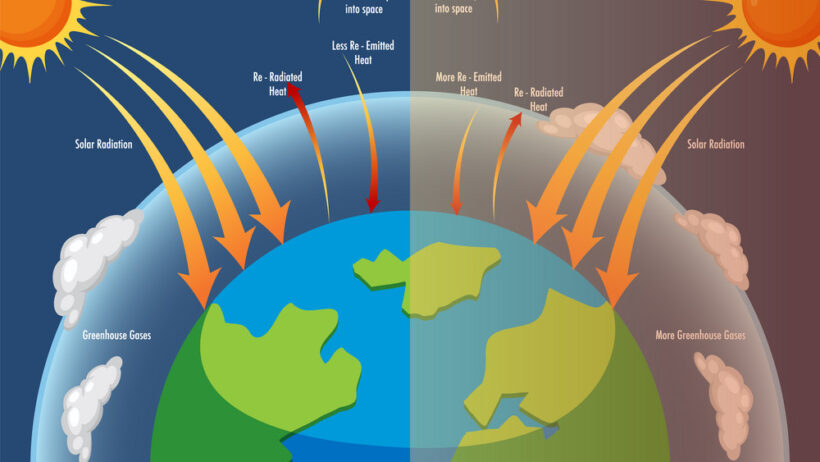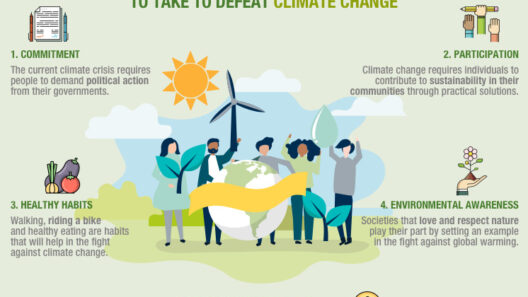The concept of greenhouse gases (GHGs) is not merely a scientific discussion; rather, it is a crucial narrative that highlights the interplay between human activity and the planet’s climate. As we contemplate the future of Earth, understanding how GHGs are warming our planet—one molecule at a time—is of paramount importance. To elucidate this phenomenon, we must explore the constituents of the atmosphere, the mechanisms of heat retention, and the consequential shifts in environmental equilibrium.
Greenhouse gases include carbon dioxide (CO2), methane (CH4), nitrous oxide (N2O), and water vapor. While some of these gases occur naturally, anthropogenic activities—particularly the burning of fossil fuels, deforestation, and extensive agricultural practices—have significantly augmented their concentrations. The intricate dance of these molecules with solar radiation forms the cornerstone of the greenhouse effect, a natural process that maintains the Earth’s temperate climate. However, the balance is precariously tilted by human intervention.
To grasp the greenhouse effect, one must first understand how energy flows into and out of Earth’s atmosphere. Solar energy reaches our planet predominantly in the form of visible light. The Earth absorbs a portion of this energy to sustain life and then emits it back into space as infrared radiation. However, GHGs trap some of this outgoing infrared energy, creating a ‘blanket’ around the planet. This phenomenon serves to warm the atmosphere, facilitating a climate suitable for the diverse ecosystems that thrive on Earth.
The effective warming caused by greenhouse gases is often quantified using the term “radiative forcing,” which refers to the difference in energy absorbed by the Earth and energy radiated back into space. Positive radiative forcing indicates a warming trend incited by increased GHG concentrations. For instance, CO2, which has a longevity in the atmosphere of hundreds to thousands of years, significantly contributes to this imbalance. Each molecule of CO2 released into the atmosphere does not merely dissipate but accumulates, perpetuating a chain reaction of warming effects.
The numbers are staggering: in pre-industrial times, CO2 levels hovered around 280 parts per million (ppm). Modern records reflect concentrations exceeding 400 ppm. This increment may appear minuscule, but the repercussions on a planetary scale are profound. Increased CO2 levels lead to enhanced thermal radiation absorption, and subsequently, a gradual increase in global temperatures. Notably, every molecule of CO2 has a warming potential, accumulating and intensifying heat retention over time.
Methane, another formidable greenhouse gas, possesses an even more potent warming potential—over 25 times that of CO2 over a 100-year period. While methane has a shorter atmospheric lifespan—about a decade—it is released during agricultural practices, fossil fuel extraction, and waste management processes. Its molecular structure allows it to trap heat efficiently, making it an immediate concern for climate regulation. As methane concentrations rise, we witness rapid shifts in local and global climates: droughts, floods, and erratic weather patterns that disrupt natural ecosystems and human livelihoods alike.
Complementing CO2 and methane, nitrous oxide poses its own unique threat to climate stability. Emissions primarily arise from agricultural soil management practices and nitrogen-fertilizer use. While it is less abundant than CO2, its warming potential can be as much as 298 times greater than CO2 over a century. The intricate relationships among these gases underline the complexity of contributing factors to climate change and pose challenges in formulating effective mitigation strategies.
As we probe the consequences of these emissions, the implications extend beyond mere temperature elevation. Ocean acidification resulting from increased CO2 levels poses a formidable threat to marine life, particularly organisms that depend on calcium carbonate for their skeletal structures. Coral reefs, which serve as vital biodiversity sanctuaries, are under siege from both warming waters and acidification, leading to bleaching events and ecosystem degradation.
The terrestrial biosphere also feels the heat. Warmer conditions can exacerbate the frequency and severity of wildfires, threatening forests and grasslands, vital carbon sinks that naturally combat GHG emissions. Additionally, altered precipitation patterns complicate water availability, impacting agriculture and leading to food insecurity across regions. The interconnected system of climate, water, and land forms a delicate balance that, once disrupted, can spiral into irreversible changes.
Understanding the gravity of the situation is crucial for grappling with climate change. The urgency calls for a transformative approach in how societies consume energy, develop infrastructure, and engage in agricultural practices. Historical examples illuminate that proactive measures can yield tangible results; the reduction of leaded gasoline usage has led to observable decreases in atmospheric lead levels. Similar frameworks can be employed to mitigate greenhouse gas emissions effectively.
Transitioning to renewable energy sources, enhancing energy efficiency, and fostering carbon capture technologies are essential strategies in the fight against climate change. Grassroots movements and governmental policies must collaborate to create frameworks that facilitate a sustainable future. Educational campaigns can foster awareness and inspire individuals and communities to adopt eco-friendly practices, igniting a collective consciousness around environmental stewardship.
Finally, the narrative surrounding greenhouse gases and climate change must transcend the scientific community, permeating public discourse and prompting societal action. Every individual possesses the potential to contribute to this vital cause, embodying advocacy for sustainable practices in daily choices. Whether through reducing carbon footprints, supporting renewable energy initiatives, or simply cultivating awareness, the path toward a cooler, more sustainable planet begins one molecule at a time.





